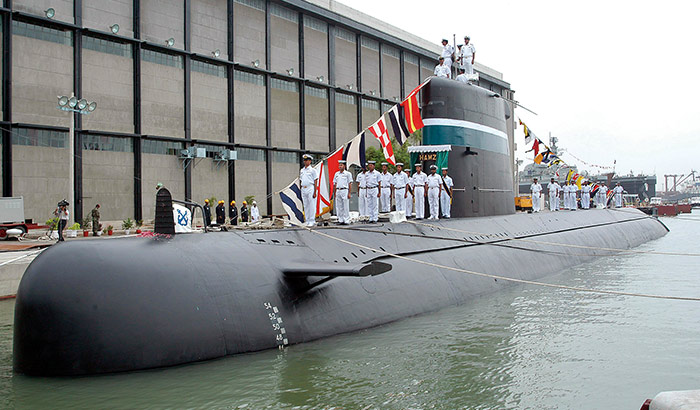Saima Aman Sial
On 9th January, 2017, Pakistan test fired a sea-variant of Babur cruise missile, with a range of 450 km, from an underwater movable platform. The ISPR Press release stated in this regard that, “the successful attainment of a second strike capability by Pakistan represents a major scientific milestone; it is manifestation of the strategy of measured response to nuclear strategies and postures being adopted in Pakistan’s neighbourhood.” One might ask whether the development of an under-sea nuclear capability by Pakistan is a reaction to India’s nuclearization of the Indian Ocean or a standalone development? What are Pakistan’s motivations that have led to this development?
With the rationale for the development of its nuclear weapons mainly driven by security, important tenets of Pakistan’s nuclear doctrine suggest the same. Pakistan’s nuclear deterrence has clearly been established against India. Credible Minimum Deterrence (CMD) is considered to be the guiding nuclear policy. However, the credibility demanded that nuclear deterrence not be conceptualized in a vacuum but made relative to the technological advancements and developments in the regional strategic environment.
Pakistan’s CMD did not initially entail development of a nuclear triad, as was reflected by Pakistan’s response to India’s draft nuclear doctrine of 1999. However, as the Cold War nuclear competition showed, a nuclear dyad is stable only when both sides have capabilities that are survivable. Fear of pre-emption is highly destabilizing for deterrence. Therefore, after India’s nuclearization of the Indian Ocean exhibited by the launch of a nuclear submarine INS Arihant (SSBN) in 2009, Pakistan seriously started considering developing a sea-based nuclear capability, as manifested in the country’s decision of establishing the headquarters of the Naval Strategic Forces Command (NSFC) in May 2012.
The rationale for Pakistan’s development of a credible second strike capability is multi-causal. Primarily, it is driven by the logic of a stable deterrence equation between two nuclear-armed adversaries. In a nuclear dyad, deterrence is stable where neither side has an incentive for a decapitating first strike. This requires the nuclear deterrent forces to be survivable and possibly able to evade a first or preemptive strike. However, in South Asia, owing to India’s development of an assured second strike capability alongside advancements in Ballistic Missile Defense system (BMD), the fear of decapitation of Pakistan’s nuclear forces becomes too real. The BMD gives psychological superiority to the possessor to carry out a decapitating first strike and take out the residual incoming nuclear weapons of its adversary through the BMD shield. The adversary then has two options. First, to increase the number of its nuclear missiles/platforms to evade decapitation or second, to go to sea to enhance the survivability of its nuclear forces. Clearly for Pakistan, India’s attempts at BMD acquisition and augmentation of its second strike capability have been a motivation for development of its own undersea nuclear deterrent. The ISPR statement reflects this much, “the missile features terrain hugging and sea skimming flight capabilities to evade hostile radars and air defences, in addition to certain stealth technologies, in an emerging regional Ballistic Missile Defence (BMD) environment.”
Pakistan has to deal with the curse of geography as well. Lack of strategic depth has complicated the challenge of survivability of Pakistan’s nuclear forces. Pakistan has been using mobility and concealment as means to retain the survivability of its land-based nuclear arsenal. The mountainous terrain provides a natural survivability means (much like the hardened silos) in this regard. There is an underground tunneled rail system through which the missiles are moved on mobile launchers. However, two decades since nuclearization, advancements in the Intelligence, Reconnaissance and Surveillance (ISR) capabilities are increasingly becoming a challenge for the survivability of Pakistan’s land-based mobile assets. India is currently upgrading its indigenous ISR capabilities by acquisition of drone technology in collaboration with other international partners. India’s agreement with the United States for sharing information on ‘vital security aspects’ in the realm of space as well as sharing of satellite data for ‘maritime domain awareness’ demonstrates the shifting landscape in this regard. In this emerging scenario, Pakistan’s development of a sea-based second strike capability can be attributed to strengthening the credibility and survivability of its nuclear force.
In Pakistan’s nuclear use doctrine, the economic threshold features as one of the thresholds for possible use of nuclear weapons. Considering that bulk of Pakistan’s trade is carried through sea (more than 96 percent), any blockade of the Sea Lanes of Communication (SLOCs) would lead to a nuclear precipice for Pakistan. The economic threshold and fear of a possible blockade therefore demands acquisition of capabilities that strengthen Pakistan Navy’s (PN) sea denial strategy.
Owing to its conventional inferiority vis-à-vis a bigger naval force and a checkered history of wars, Pakistan’s naval strategic thought accords a lot of importance to platforms that aid its overall naval strategy of offensive defense. A submarine armed with cruise missiles fits well with that strategy. It allows Pakistan Navy to retain leverage on both conventional and nuclear domains.
The most likely platform for Pakistan’s Babur-III cruise missile would be the recent Agosta 90-B submarines, equipped with the air-independent propulsion (AIP) systems that help them remain submerged under water for longer periods. Being diesel-electric submarines they also have an advantage of being quieter than the nuclear submarines. Agostas will most likely serve to be Pakistan’s version of a survivable second strike force.
A nuclear submarine armed with ballistic missile (SSBN) is an ideal platform for featuring an assured second strike force and the operational deployment of the platform requires at least 3-5 submarines. However, the SSBNs are a costly undertaking and Pakistan’s Agosta’s equipped with AIP serves the purpose of a survivable deterrent force just so credibly, without being too expensive a platform. Operationalization of a nuclear deterrent force at sea would have implications for Pakistan’s nuclear doctrine, force posture and command & control that would require serious deliberations within the strategic decision-making community.
Saima Aman Sial is a Senior Research Fellow at the Center for International Strategic Studies, Islamabad.

















